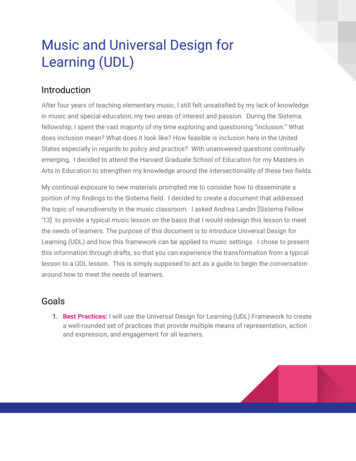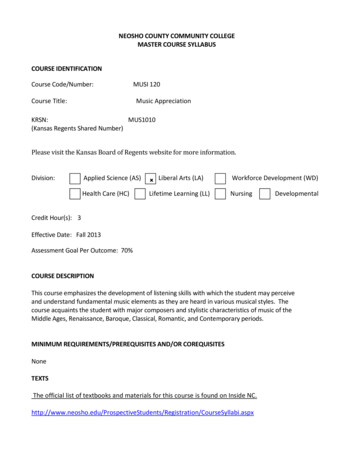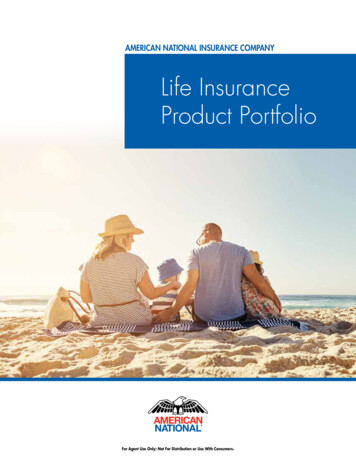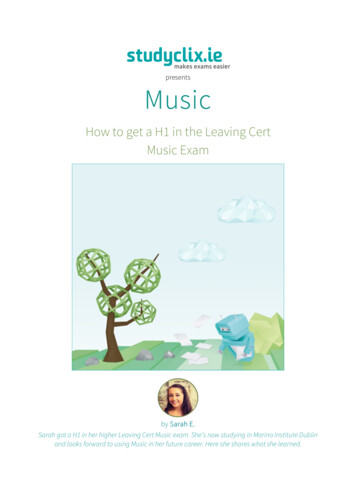
Transcription
Music and Universal Design forLearning (UDL)IntroductionAfter four years of teaching elementary music, I still felt unsatisfied by my lack of knowledgein music and special education, my two areas of interest and passion. During the Sistemafellowship, I spent the vast majority of my time exploring and questioning “inclusion.” Whatdoes inclusion mean? What does it look like? How feasible is inclusion here in the UnitedStates especially in regards to policy and practice? With unanswered questions continuallyemerging, I decided to attend the Harvard Graduate School of Education for my Masters inArts in Education to strengthen my knowledge around the intersectionality of these two fields.My continual exposure to new materials prompted me to consider how to disseminate aportion of my findings to the Sistema field. I decided to create a document that addressedthe topic of neurodiversity in the music classroom. I asked Andrea Landin [Sistema Fellow‘13] to provide a typical music lesson on the basis that I would redesign this lesson to meetthe needs of learners. The purpose of this document is to introduce Universal Design forLearning (UDL) and how this framework can be applied to music settings. I chose to presentthis information through drafts, so that you can experience the transformation from a typicallesson to a UDL lesson. This is simply supposed to act as a guide to begin the conversationaround how to meet the needs of learners.Goals1. Best Practices: I will use the Universal Design for Learning (UDL) Framework to createa well-rounded set of practices that provide multiple means of representation, actionand expression, and engagement for all learners.
22. Classroom Environment: A large part of reaching every learning is creating anenvironment that is conducive to multiple learning styles. This portion will give you tipsaround classroom setup and management and ways to make the music room suitablefor every musician.3. Resources: Because there can never be enough!FormatAndrea Landin, New West Symphony, sent a typical lesson from her program. This documententails the 1) original lessons 2) suggestions to consider before implementing UDL 3) a UDLlesson 4) classroom environment and 5) extra resources.Andrea’s Original Lesson1. Warm-up: students choose scales (1 flat scale, 1 sharp scale) Two different student leaders choose rhythm, bowing, dynamic2. Start new scale: F# Major (we are working towards learning all 12 major scales):Determine key signature, give students 1 min on their own to find accidentals on theirinstrument Play through scale on whole notes, letting students adjust pitches as necessary (I willplay with them) Play with quarter notes; new rhythms if they feel comfortable with it3. Structured Improvisation with new scale "Rhythm Machine": each student chooses 1-2 notes of the F# major scale, creates asimple rhythm (one 4/4 measure); students come in one by one, dynamic build up,then drop out one by one (variation: "soccer", where students "pass the ball" by lookingat each other and coming in/dropping out randomly) If time/comfort level: Improvised melodies over F# pedal (they are still doing verysimple, few note melodies)4. El Condor Pasa - with everyone learning melody for now
3 Measures 1-6: work on 8th rests by substituting them with notes, then taking themout (we used visuals/the whiteboard for this) Individual practice in 1-2 minute chunks Goal for today: up to measure 12Suggestions:1. Warm-up: students choose scales (1 flat scale, 1 sharp scale) Two different student leaders choose rhythm, bowing, dynamic2. Start new scale: F# Major (we are working towards learning all 12 major scales):Determine key signature, give students 1 min on their own to find accidentals on theirinstrument Play through scale on whole notes, letting students adjust pitches as necessary (I willplay with them) Play with quarter notes; new rhythms if they feel comfortable with it3. Structured Improvisation with new scale "Rhythm Machine": each student chooses 1-2 notes of the F# major scale, creates asimple rhythm (one 4/4 measure); students come in one by one, dynamic build up,then drop out one by one (variation: "soccer", where students "pass the ball" by lookingat each other and coming in/dropping out randomly) If time/comfort level: Improvised melodies over F# pedal (they are still doing verysimple, few note melodies)4. El Condor Pasa - with everyone learning melody for now Measures 1-6: work on 8th rests by substituting them with notes, then taking them out(we used visuals/the whiteboard for this) Individual practice in 1-2 minute chunks Goal for today: up to measure 12
4Andrea’s UDL LessonObjective: Play El Cando Pasa up to measure 12Key Questions: What is the difference in the F# scale and a B scale?Lesson Pre Assessment: Students will be able to play an F# scaleBarrier to Learning: Short time frame to master a new scale, Prior knowledge is a necessityPlanning with UDL in mindMultiple Means ofRepresentationExamples:Visual Cue CardsEnlarged TextSchedulePeer BuddiesRead AloudVisual CuesPicture ChoicesEmotions ChartDiceMusic BankMusic ThesaurusPractice ChecklistModel BehaviorsMetacognitive note takingMultiple Means ofAction/ExpressionExamples:Choice BoardsSensory BottlesAdapted MusicBreak CardsMultiple representations ofnote valuesExemplarsSentence startersWord bankBig booksJigsawSubset of a warmupI message sentence starters(I want therefore I must )1. Class Schedules and Expectations Students come in and take their seatsMultiple Means ofEngagementExamples:Peer performancesGroup collaboration workChunkingRubricsVisual task scheduleSocial narrativesContractsFirst-then statementsGoal settingGuiding questionsLearning logsProblem-solving checklistsSensory toolkitCalming spaces
5 The teacher goes over the agenda for the day and lets students know if there’s anychange to the schedule or if there’s any event coming up Then the teacher goes over his/her expectations for the class Goal is presented UDL Ideas: visual cue cards, visual and written schedule, rubric for goal, learning log2. Scale Warm Up The scale is put up on the board for visualization assistance. It may be helpful to havenotes in colors (all C’s yellow, etc ). If a student has difficulty looking at the boardgive that student his/her own copy. All students play the scale together Repeat for any other scale Two different student leaders choose rhythm, bowing, dynamic If a student student struggles to play the scale differently just break the classinto two groups One group begins with the original scale and then group 2 plays the alteredscale Have the groups switch and make that student leads UDL Ideas: Visual choices (colors vs. black and white), Choral Playing (when theteacher plays and student follows along with finger), Chunking, Group collaboration(have one group play four notes and the next play 3),3. Start new scale: F3 Major Ask students to quietly look over the scale and count how many accidentals they’ll see Then ask them to compare answers with their stand partner Play through scale on whole notes, letting students adjust pitches as necessary (I willplay with them) Play with quarter notes; new rhythms if they feel comfortable with it UDL Ideas: Exemplars, sentence starters, problem-solving checklists3. Structured Improvisation with new scale "Rhythm Machine": each student chooses 1-2 notes of the F# major scale, creates asimple rhythm (one 4/4 measure); students come in one by one, dynamic build up,then drop out one by one (variation: "soccer", where students "pass the ball" by lookingat each other and coming in/dropping out randomly) If time/comfort level: Improvised melodies over F# pedal (they are still doing verysimple, few note melodies)
6 UDL Ideas: Music thesaurus (make sure words used in the warm up are displayedin the room with a definition and picture), Another option for eye contact- verbalcue to pass rhythm, choice board4. El Condor Pasa - with everyone learning melody for now Measures 1-6: work on 8th rests by substituting them with notes, then taking them out(we used visuals/the whiteboard for this) Individual practice in 1-2 minute chunks Goal for today: up to measure 12 UDL Ideas: Peer performance, peer buddies, model behaviors (student model how toplay), learning log at end, problem-solving checklistClassroom EnvironmentClassroom environment is critical to the learning process. Although, there are many factorsthat weigh into classroom environment I’m going to focus on 5. I recognize that each Sistemaprogram is different, so take what you can!1. Expectations and SchedulesAs everyone already knows, schedules and expectations are extremely important. Forstudents with disabilities schedules are key. There needs to be clear communication ifa schedule is going to change and with as as much ahead time as possible. Below areexamples from an elementary classroom.
0069.jpg2. Labels and PicturesThis is extremely important for students who are nonverbal but useful for everystudent. By simply labeling materials that are used on a daily basis, you’re helpingstudents build a working memory of where items and go and also how to take care ofthe materials they use.
83. Different representations of materialDisplay information that students need to know to be successful. Do not rely on thesheet music itself. Present the information in multiple formats.
94. DirectionsSlow down on directions and break them down succinctly. For example, instead ofopen your books to page 43 and got to measure 8. Instead try:1. Take our your music book2. Put it on the music stand3. Open to page 434. Find measure 85. Put your finger on measure 86. Check with your stand partner to make sure you’re both in the same place.5. Word WallsA classroom word wall or word poster will help students categorize learningthroughout the weeks. It’s often helpful to carry around a word poster, so thatstudents don’t lose the knowledge from last week or the day before. Just use velcroand posterboard to make transferable boards.
I/AAAAAAAAA6w/cD3m9DlZBSs/s1600/Notation Constellation.JPGResources1. Visual cue cards l-Resources-for-Music-Class-11864172. Sensory Bottles : When a student gets upset allow them to use the sensory bottle.Simply have them turn it over and once the beads/sparkles/etc settles to the bottomthey need to come back to class. Step by step instructions on how to make ry-bottles3. Calm Down calm-down-kit.html?spref pi&m 1
114. Fidget Gloves ; Helps students with fine motor d-on-pinterest-tested-in-therapy-test-pin-5/5. Finger Warm Up: Play arpeggios to any scale and have students warm up by havingthem touch their fingers to their thumb. It was originally used as an occupationaltherapist warm up but works well in the music classroom. Video of a writing warm up(can be used in music)6. ADHD Chair Options: Here’s a list of resources you can use to modify chairs forstudents with hyperactivity or any fidgety 9/supporting-students-with-sensory.html7. Zones of Regulation: Here’s a guide to help students learn to self-regulate. It includeshow to deal with certain feelings and strategies to work past s-of-regulation-helping-my.html8. Social Stories and Language Boards: Helpful for students who struggle .com/2013/10/aidedlanguageboards.html9. Free UDL Book!! http://udltheorypractice.cast.org/login
1210. UDL Strategies: ww.udlcenter.org/
around classroom setup and management and ways to make the music room suitable for every musician. 3.Resources: Because there can never be enough! Format Andrea Landin, New West Symphony, sent a typical lesson from her program. This document entails the 1) original lessons 2) suggestions to consider before implementing UDL 3) a UDL











